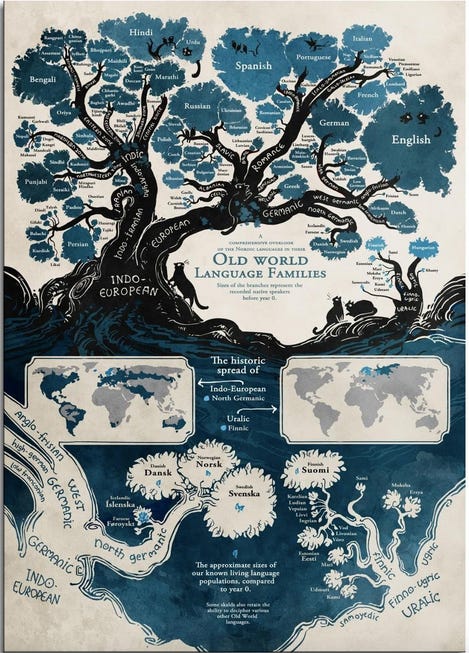Language
In recounting the myth of the evolution of mankind's history, evolutionists also encounter a number of serious problems. One is how human consciousness emerged in the first place. Another concerns the origin of speech—one characteristic that distinguishes human beings from all other living creatures. It is expressed in our human genes called the FOXP2 gene. It was the first gene to be clearly linked to speech and language development. When we speak, we are able to shape our thoughts thanks to language, and to express them in such a way that someone else can understand them. Although this requires highly specialized muscular movements of the lips, throat and tongue, we are hardly aware of this. We merely "want" to speak. Sounds, syllables and words emerge through the harmonious contraction and relaxation of some 100 different muscles, and sentences comprehensible to others are formed by the appropriate sequences of such grammatical elements as subject, object and pronoun. The fact that we do nothing more than "wish" to use such an ability, based on such complex stages, clearly shows that speech is not merely an ability that arises from essential biological structures.
The human capacity for speech is an exceedingly complex phenomenon that cannot be explained in terms of the imaginary requirements or mechanisms of an evolutionary process. Despite lengthy research, evolutionists have been unable to produce any evidence that an exceedingly complex ability like speech evolved from simple animal-like sounds.
Linguist Derek Bickerton states,
Could language have come directly out of some prehuman trait? No. Does it resemble forms of animal communication? No . . . no ape, despite intensive training, has yet acquired even the rudiments of syntax . . . how words emerged, how syntax emerged. But these problems lie at the heart of language evolution.
All languages on Earth are complex, and not even evolutionists are able to imagine how such complexity could have been acquired gradually. Two evolutionist brain researchers, W.K. Williams and J. Wakefield of Arizona State University, say this on the subject:
“Despite the lack of evidence for intermediate stages in linguistic evolution, the alternatives are hard to accept. If some species-specific characteristic did not evolve in piecemeal fashion, then there would seem to be only two ways to explain its appearance. Either it was put in place by some still-undiscovered force, perhaps through divine intervention, or it was the result of some relatively abrupt change in the development of the species, perhaps some sort of spontaneous and widespread mutation . . . but the fortuitous nature of such a happenstance mutation makes that explanation seem suspect. As has been pointed out (Pinker and Bloom, 1990), the chances against a mutation resulting in a system as complex and apparently so ideally suited to its task as is language are staggeringly high.”
In the same way that evolutionists are unable to account for the complexity of the biological structures that enable speech, they are also unable to explain the origin of the consciousness that makes language possible. Human consciousness and the complexities of language show that language was created by God.
Salient points to note here about language:
* instead of evolving…… language devolves. If man evolved from less intelligent creatures, we would expect the earliest languages to be the least complex. The exact opposite is true.
* early languages are much more complex in verb usage & syntax. For example, ancient Greek & ancient Chinese are much more complex than their modern counterparts. Ancient Sanskrit goes back to 1500 BC and each verb had up to 500 variations!
* compare this to English in which most verbs have only five forms (do-does-did-done-doing). Ancient Chinese had 6000 “characters” or letters compared to modern English with 26.
* In reality, man had complex language from the beginning, as the Bible indicates.
This Substack is reader-supported. To receive new posts and support my work, consider becoming a free or paid subscriber.
The evolutionary picture of ancient man does not match the empirical evidence in fields such as archaeology nor in its historical context. Have you ever heard that the people described as “primitive cavemen” possessed an artistic ability and understanding just as refined as those of modern artists? Did you know that the Neanderthals, whom evolutionists portrayed as “ape-men,” made houses, clothing, shoes, and took pleasure in music? In all probability you may never have heard any of these facts. On the contrary, you may have been handed the mistaken impression that these people were half-ape and half-human, unable to stand fully upright, lacking the ability to speak words and producing only strange grunting noises. That is because this entire falsehood has been imposed on society. The motive behind it is to keep alive an evolutionary philosophy which denies the existence God.
Since evolutionists claim that the universe has no Creator, they must provide their own explanation for how the life and myriad species on Earth came into being. The theory of evolution is the scenario they employed for that purpose. Before the Ancient Astronaut Theory, evolution suggested that all the order and life in the universe came about spontaneously by time and chance. Inanimate substances in the primeval world combined by accident to give rise to the first living cell. As a result of millions of years of similar coincidences, organisms came into existence. Consequently, human beings came on the scene, as the final stage of this supposed evolutionary chain. There are also those who hold to the Ancient Astronaut Theory suggesting that ancient aliens (extra-terrestrials) came to earth from other galaxies seeding their DNA into the human population and bringing advanced technology with them! This theory, known as the “Panspermia Theory” is an attempt to explain the causality of the complex design of life and living systems. What an oxymoron!
The primary reason why the theory of evolution ended up in such a dead end regarding the origin of life is that even those living organisms deemed to be the simplest have incredibly complex structures. The cell of a living thing is more complex than all of our man-made technological products. Today, even in the most developed laboratories of the world, a living cell cannot be produced by bringing organic chemicals together. The conditions required for the formation of a cell are too great in quantity to be explained away by coincidences. The probability of proteins, the building blocks of a cell, being synthesized coincidentally, is 1 in 10,950 for an average protein made up of 500 amino acids. In mathematics, a probability larger than 1050 is considered impossible in practical terms. In fact, there are just 1080 number of electrons in the universe! The DNA molecule, which is located in the nucleus of a cell and which stores genetic information, is an incredible databank. If the information coded in DNA were written down, it would make a giant library consisting of an estimated 900 volumes of encyclopedias consisting of 500 pages each. A very interesting dilemma emerges at this point: DNA can replicate itself only with the help of some specialized proteins (enzymes). However, the synthesis of these enzymes can be realized only by the information coded in DNA. As they both depend on each other, they have to exist at the same time for replication. This brings the scenario that life originated by itself to a deadlock. Prof. Leslie Orgel, an evolutionist of repute from the University of San Diego, California, confesses this fact in the September 1994 issue of the Scientific American magazine:
“It is extremely improbable that proteins and nucleic acids, both of which are structurally complex, arose spontaneously in the same place at the same time. Yet it also seems impossible to have one without the other. And so, at first glance, one might have to conclude that life could never, in fact, have originated by chemical means.”
Usually the simplest explanation is the best. In science, this is known as “Ockham’s Razor”. In order to choose among these possible theories, a very useful tool is what is called Ockham’s Razor. Ockham’s Razor is the principle proposed by William of Ockham in the fourteenth century: “Pluralitas non est ponenda sine necessitate,” which translates as “Entities should not be multiplied unnecessarily.” In many cases this is interpreted as “keep it simple,” but in reality the Razor has a more subtle and interesting meaning. Suppose that you have two competing theories which describe the same system, if these theories have different predictions… it is a relatively simple matter to find which one is better: one does experiments with the required sensitivity and determines which one give[s] the most accurate predictions.
The simplest explanation for the origin of DNA, using the principle of Ockham’s razor, is that it was designed somewhat like a computer memory chip and the original life information was loaded into it by the designer. No doubt, if it is impossible for life to have originated from natural causes, then it has to be accepted that life was "created" in a supernatural way. This fact explicitly invalidates the theory of evolution, whose main purpose is to deny the Creator- the God of the Bible.
Final Thoughts
The early history of mankind—which is alleged to have come into being as the result of millions of accidental mutations, each more impossible than the last—has been distorted to fit in with this scenario. According to the evolutionists’ account, the history of mankind is as follows: in the same way that life forms progressed from a primitive organism up to man, the most highly developed of all, so mankind’s history must have advanced from the most primitive community to the most advanced urban society. In order to account for the supposed evolutionary process that they claim extends from a single cell to multi-celled organisms, and then from apes to man—have rewritten the history of mankind. These concepts have now been falsified because of recent advances in science—particularly in the fields of biology, paleontology, microbiology and genetics—have totally destroyed the claims of evolution. The idea that species evolved and transformed into “later” versions of each other such as birds to dinosaurs concept is an illogical conclusion. In the same way, human beings did not evolve from ape-like creatures. Human beings have been human since the day they came into existence, and have possessed a sophisticated culture from that day to this. Evolution never happened.
Thanks for reading!
PS. If you loved this article, be sure to check out our Ancient Pathways Patreon site with loads of content for free subscribers and exclusive content for members such as “Ancient Artwork”, the book “Giants: Against Evolution, and our “Out of Place Artifacts Digital Library” all available for download.
Get the new book “Decoding Göbekli Tepe” here. Now available on Kindle!
If you loved it, please leave us a stellar Amazon review! It helps the book trend on Amazon. And as always, thank you for your support!





